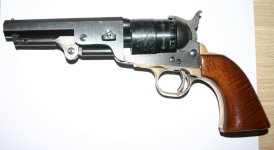Pietta 1851 Navy fiasco
The gun I purchased was made by F. LLI Pietta historical weapons reproduction. There is a very well documented instruction book and the manual also covered several other black powder models sold by them. Each model had specifics directed to that gun and general instructions for all. The do’s and don’ts were well written and easily understood. Loading, shooting, disassembly for cleaning and safety was discussed for each gun in the manual as well as general gun handling safety and specific black powder safety.
Before I started feeding powder and lead to my new gun I spent a considerable amount of time getting to know it. Having owned other single action revolvers in the past made me a firm believer in knowing your gun before you attempt to shoot it. The first thing I was interested in was disassembly for cleaning. There is one thing about a black powder gun that is more truer than any other gun. The more you shoot, the dirtier it gets.
I proceeded to fully disassembling the gun for inspection and initial cleaning and oiling. There was a lot of black smudge in the workings which appeared to be dried machine oil and metallic particles. I used a plastic scraper, alcohol and cotton swabs to clean it up. The cylinder was removed by sliding it off the spindle and then wiping down the cylinder and spindle with alcohol. At the base of the spindle was an accumulation of the black substance found elsewhere and was scraped out and wiped down with alcohol. With the frame pieces cleaned I then concentrated on the cylinder.
Except for the six removable nipples the cylinder is one solid piece. The nipples appeared to have some brown substance around them which looked like locktite. Since these would have to be changed out or cleaned I decided that removing them now and cleaning that area was in order. Using the supplied nipple wrench I discovered that no two nipples were in the same tightness and one was actually loose. The brown substance was scraped and wiped away with alcohol and the area cleaned. The nipples themselves were soaked in alcohol and then brushed and cleaned. I discovered that two of the nipples had ports that were clogged with the brown substance. I holed these out and checked the other four to make sure the ports were clear.
I then oiled each component and reassembled the gun making sure that the trigger spring received of few drops of lubrication. Considering how dirty it was before I took it apart I was not surprised on how much better everything worked after I was finished.
The other item of concern is the softness of the cylinder metal. After cocking the hammer approximately 100 times during the cleaning and tuning period, I started to notice peening to the sides of the cylinder stop grooves. The cylinder stop that pops up from above the trigger to halt the rotation of the cylinder has such tight tolerances that it peened the side of the slots to such a degree that the cylinder will rotate off center when the hammer is cocked back causing a dangerous situation. Not only was the hammer not lined up with the firing cap, but the ball in the cylinder was no longer lined up with the barrel. If the gun was fired in this condition it could cause an explosion possibly injuring the person firing the gun, in this case me! After contacting my gunsmith I did three things to rectify the problem. First, I filed the rising top edge of the cylinder lock mechanism so that it would slide into the cylinder stop slot in case of a slide by thus locking the cylinder into the correct alignment. Second, I ordered another cylinder from the store I purchase the gun at, and third I got online to post my results to the online forum where black powder enthusiasts share their information about their guns on the stores website.
The manufacturer of my gun knew that makes reproduction guns although they do make a lot of models of old west guns. My experience in the disassembly and the overall condition of the gun new out of the box would not allow me to suggest loading and shooting it before initial cleaning and inspection. The condition of the components of the gun from the factory suggests quick assembly with little care to cleaning and detail. In my opinion, the gun would not be safe to shoot out of the box based on the condition of my gun. After working down all sharp edges and sanding down the high lips of the hand grip I feel it could be a serviceable gun.
I will let you know what the shooting results are when I actually get to load it. Now it's off to shoot my 1858 Texas .44!

